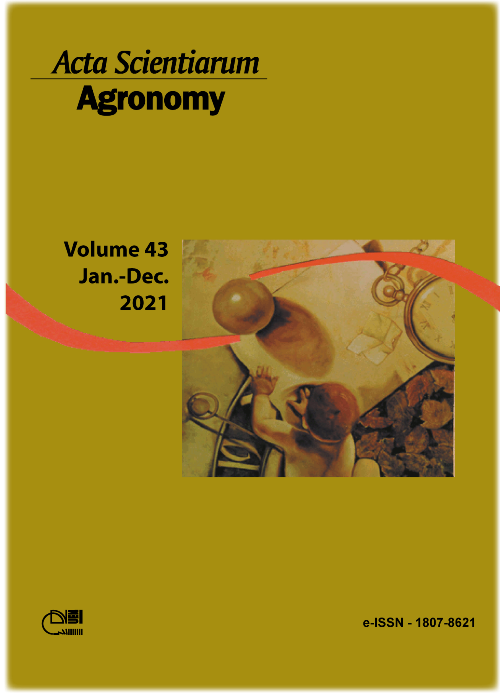Genetic parameters of soybean populations obtained from crosses between grain and food genotypes
Resumo
In addition to the agronomic traits of interest, soybean cultivars destined for human consumption must have specific attributes that meet the demands of the consumer market. To meet this demand, this study aimed to select progenies with agronomic and commercial traits of interest from soybean populations obtained from crosses between different food and grain genotypes and to estimate the genetic parameters of these populations. The F3:4 and F4:5 progenies that originated from the two crosses were evaluated in the 2015/16 and 2016/17 agricultural years, respectively, using the pedigree method. The experimental design utilized augmented blocks, while statistical analyses were performed by using the REML/BLUP methodology. The evaluated traits were plant height at maturity (APM), insertion height of first pod (AIV), lodging (AC), agronomic value (VA), number of pods per plant (NV), number of days to maturity (NDM), number of branches (NR), number of nodes (NN), 100-seed weight (PCS), and grain yield per plant (PG). The best progenies were selected, and the following genetic parameters were estimated: genetic variance, phenotypic variance, heritability, and selective accuracy. The estimates of the genetic parameters indicate the presence of high genetic variance in these populations. Heritability was high for most of the traits, indicating good potential for the selection of superior genotypes.
Downloads
Referências
Andrade, A. E. C. B., Silva, A. J., Ferraudo, A. S. E., Unêda-Trevisoli, S. H., & Di Mauro, A. O. (2016). Strategies for selecting soybean genotypes using mixed models and multivariate approach. African Journal of Agricultural Research, 11(1), 23-31. DOI: 10.5897/AJAR2015.9715
Bernardo, R. (2003). On the effectiveness of early generation selection in self-pollinated crops. Crop Science, 43(4), 1558-1560. DOI: 10.2135/cropsci2003.1558
Bhat, S., Basavaraja, G. T., & Salimath, P. M. (2012). Analysis of variability in segregating generation of soybean [Glycine max (L.) Merrill]. Karnataka Journal of Agricultural Sciences, 25(2), 176-178.
Brogin, R. L., Arias, C. A. A., & de Toledo, J. F. F. (2003). Genetic control of soybean resistance to brown spot (Septoria glycines): first studies. Crop Breeding and Applied Biotechnology, 3(1), 35-44.
Carvalho, A. D. F., Neto, R. F., & Geraldi, I. O. (2008). Estimation and prediction of parameters and breeding values in soybean using REML/BLUP and Least Squares. Crop Breeding and Applied Biotechnology, 8(3), 219-224.
Castoldi, R., Charlo, H. C. D. O., Vargas, P. F., Braz, L. T., & Carrão-Panizzi, M. C. (2011). Agronomic characteristics, isoflavone content and Kunitz trypsin inhibitor of vegetable soybean genotypes. Horticultura Brasileira, 29(2), 222-227. DOI: 10.1590/S0102-05362011000200015
Costa, M. M., Di Mauro, A. O., Unêda-Trevisoli, S. H., Arriel, N. H. C., Bárbaro, I. M., & Muniz, F. R. S. (2004). Ganho genético por diferentes critérios de seleção em populações segregantes de soja. Pesquisa Agropecuária Brasileira, 39(11), 1095-1102. DOI: 10.1590/S0100-204X2004001100007
Jaureguy, L. M., Chen, P., & Scaboo, A. M. (2011). Heritability and correlations among food-grade traits in soybean. Plant Breeding, 130(6), 647-652. DOI: 10.1111/j.1439-0523.2011.01887.x
Pimentel, A. J. B., Guimarães, J. F. R., Souza, M. A., Resende, M. D. V., Moura, L. M., & Ribeiro, G. (2014). Estimação de parâmetros genéticos e predição de valor genético aditivo de trigo utilizando modelos mistos. Pesquisa Agropecuária Brasileira, 49(11), 882-890. DOI: 10.1590/S0100-204X2014001100007
Pinheiro, L. C. D. M., God, P. I. V. G., Faria, V. R., Oliveira, A. G., Hasui, A. A., Pinto, E. H. G., ... Moreira, M. A. (2013). Parentesco na seleção para produtividade e teores de óleo e proteína em soja via modelos mistos. Pesquisa Agropecuária Brasileira, 48(9), 1246-1253. DOI: 10.1590/S0100-204X2013000900008
Resende, M. D. (2007). Selegen-Reml/Blup: sistema estatístico e seleção genética computadorizada via modelos lineares mistos. Colombo, PR: Embrapa Florestas.
Resende, M. D. V. (2004). Métodos estatísticos ótimos na análise de experimentos de campo. Colombo, PR: Embrapa Florestas.
Storck, L., Cargnelutti Filho, A., Lúcio, A. D., Missio, E. L., & Rubin, S. D. A. L. (2010). Avaliação da precisão experimental em ensaios de competição de cultivares de soja. Ciência e Agrotecnologia, 34(3), 572-578. DOI: 10.1590/S1413-70542010000300007
Vianna, V. F., Desiderio, J. A., Santiago, S., Junior, J. A. F., & Ferraudo, A. S. (2013). The multivariate approach and influence of characters in selecting superior soybean genotypes. African Journal of Agricultural Research, 8(30), 4162-4169. DOI: 10.5897/AJAR2013.7064
Volpato, L., Simiqueli, G. F., Alves, R. S., Rocha, J. R. D. A. S. D. C., Del Conte, M. V., Resende, M. D. V. D., ... Silva, F. L. D. (2018). Selection of inbred soybean progeny (Glycine max): an approach with population effect. Plant Breeding, 137(6), 865-872. DOI: 10.1111/pbr.12648
Zoldan, S. M., Braga, G. D. S., Fonseca, F. J., & Carrão-Panizzi, M. C. (2014). Electronic tongue system to evaluate flavor of soybean (Glycine max (L.) Merrill) genotypes. Brazilian Archives of Biology and Technology, 57(5), 797-802. DOI: 10.1590/S1516-8913201402176
DECLARAÇÃO DE ORIGINALIDADE E DIREITOS AUTORAIS
Declaro que o presente artigo é original, não tendo sido submetido à publicação em qualquer outro periódico nacional ou internacional, quer seja em parte ou em sua totalidade.
Os direitos autorais pertencem exclusivamente aos autores. Os direitos de licenciamento utilizados pelo periódico é a licença Creative Commons Attribution 4.0 (CC BY 4.0): são permitidos o compartilhamento (cópia e distribuição do material em qualqer meio ou formato) e adaptação (remix, transformação e criação de material a partir do conteúdo assim licenciado para quaisquer fins, inclusive comerciais.
Recomenda-se a leitura desse link para maiores informações sobre o tema: fornecimento de créditos e referências de forma correta, entre outros detalhes cruciais para uso adequado do material licenciado.




















































